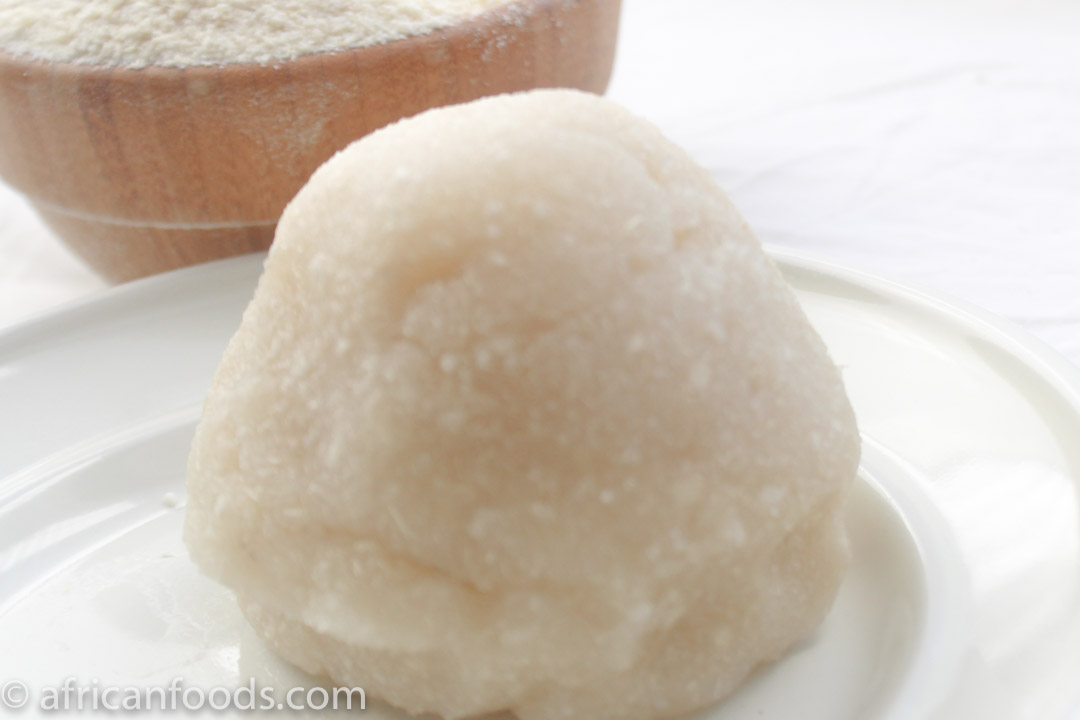Gari
Gari (garri)is a fine to coarse granular flour of varying texture made from cassava roots. Cassava is cleaned after harvesting, grated, water and starch squeezed out of it, left to ferment and then fried either in palm oil or without palm oil and serves as a major staple food in West Africa. It is also called garri or gali in some parts of sub-Saharan Africa.

Gari is food to close to 200 million persons in West Africa. It is a coarsely processed meal from cassava tubers. It feels like grain when you toch it. It is however grain-free and nut-free.
Gari is usually cheaper than the other dumplings(swallows, fufu) and the easiest to make, hence, it is popular in large households. Garri and boiling water are the only ingredients for eba; a side dish served with different vegetable stews and sauces from the region.
As a snack or lighter meal, stir gari into cold water or milk with or without sugar or salt . And a handful of nuts or smoked fish and you have a refreshing snack on a hot sunny day. If you are starting out eating gari try it this way and add whatever nuts, fruits or fish you fancy.
In Ghana, Foto Gari and yoo ke garri are popular ways of eating gari. Yoo ke garri is gari with beans. Foto gari is made by making a stew and pouring moistened gari into it. Garri is also a soup thickener.
How To Make Garri?
Gari is made from cassava, the tubers are harvested, peeled and the white pulp is grated in a garri grinding machine. Before the advent of machines, the cassava is hand grated.
The grated produce is then put into a jute sack and the sack tied. Traditionally, this is left to ferment for three to seven days depending on the type of garri been made. This step is very important, as the fermentation process helps to reduce and detoxify the high cyanide content of cassava.

While still inside the sack, sacks are stacked up on each other, and a wooden board placed below and above the sacks. The wooden boards are tied together with the sacks full of the grated cassava in between. Tension is created by tightening the rope and thus allowing water to run out of the grated cassava being processed.
Usually, by day three, the grated cassava would have lost quite some water and become reasonably dried.
This step is also been by-passed with the use of machines that compress and squeeze water out of the grated cassava.
The water running out is very rich in starch. Collected into a bowl and let to sediment, pure raw starch is obtained.
This fermented, and dried grated cassava is now sieved to remove large particles and fibres and the smaller grain-like bits are collected for further processing. This is now fried in a dry large pot. All you do here is put a thick big pot on fire, let the pot get dried, then put in some of the grated cassava and stir it until it becomes crisp. It gives off a pleasant cooked aroma. You must stir this continuously to avoid it getting burnt. The finished cooked or baked product is what is called garri.
What Are The Different Types Of Garri
There are different types of gari, depending on how it is processed, its grain size and the region of Africa it is produced.
The Standards Organization of Nigeria classifies gari into:
- Extra Fine Grain Gari - where more than 80% of the grain passes through a sieve of less than 350-micrometre aperture
- Fine Grain Gari - More than 80 % of the grains pass through a sieve of less than 1000 micrometre aperture
- Coarse Grain gari - Not less than 80% of grains passes through a sieve of 1400 micrometre, or less than 20 % of weight passes through a sieve of 1000 micrometre Extra Coarse Grain Gari - Not less than 20 % of grain is retained on a sieve of 1400 micrometre aperture.
You can choose any of the above texture sizes to meet the specific need you want your garri. Generally, for making eba, the fine grain or coarse grain gari are usually okay, and the extra coarse grain garri for soaking.
Garri can also be classified based on fermentation length (days and extent) or whether palm oil is added to make it yellow or not. Such classifications include:
- Red Gari is the type of gari commonly found in the Mid-Western part of Nigeria. It is also called Delta garri. It is made exactly the way described above, but for the addition of palm oil after grating the cassava and the gari is allowed to ferment for two to three days also. Adding palm oil to the gari further helps to reduce the cyanide content and gives it a unique flavour.
- White Gari Same as Delta gari, left to ferment for two to three days as well, with no palm oil added during processing.
- Ijebu Gari is made same way too but allowed to ferment for up to seven days. No palm oil added but fried to a crisper texture. It characteristically has a very sharp sour taste and less starchy. Many people from the Western part of Nigeria love this and find it great for “soaking”(soaked in water or milk like a cereal)
- Ghana Gari , as the name implies, is garri made in Ghana. Again the process is the same. The harvested and peeled cassava is soaked in water first. This step is skipped when making gari in Nigeria as above. After grating the peeled and soaked cassava is then sun-dried, before frying it in a pot to cook it crisp. Ghana gari thus comes out quite starchy, very crispy, and lasts very long in storage. No palm oil is added. It is great in making eba.
Is Gari A Healthy Food?
Gari is rich in starch, has very high fibre content. Contains protein and some essential vitamins. The high fibre content makes it very filling, and also makes this good in preventing or at least reduces the likelihood of constipation and bowel diseases.
Is Garri Harmful?
Gari is made from cassava. And cassava contains cyanide. For cassava to be safe for humans, cassava should be cooked, never eaten raw. The body can tolerate small amounts of cyanide. However, large doses can affect the heart, respiratory and central nervous systems. The processing of gari involves grating, fermentation and frying. Well-processed(cooked) gari is safe when eaten in moderate quantities.
Want regular updates on African cuisines and food recipes? What about unique health information about these foods - what to eat and avoid to keep healthy from the list of African recipes available?
Fill in the form below to subscribe to our Newsletter - AfricanFoods Weekly?
Worried about spamming? We are too. We will never ever give or pass on your information to anyone else. We will only use your email address to send you your copy of our weekly newsletter. We do have a zero tolerance to spam. We subscribe to a very strict policy on the handling and use of information we gather on this site! We also get paid for affiliate links on this site. See our privacy policy for further details.
Follow us on social media:
Get Our Weekly Newsletter. Subscribe Today. It's FREE.
Subscribe to African Foods Weekly
Get African food recipes, cooking tips, and healthy eating info delivered to your inbox every week. Simply fill in your email below and click SUBSCRIBE .
(Your information will not be shared)










New! Comments
Have your say about what you just read! Leave me a comment in the box below.